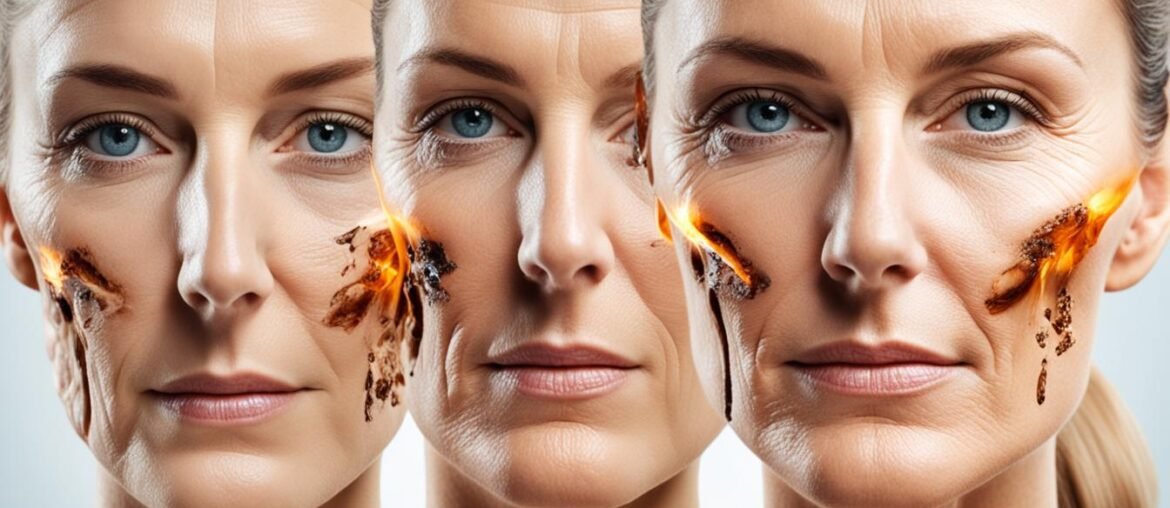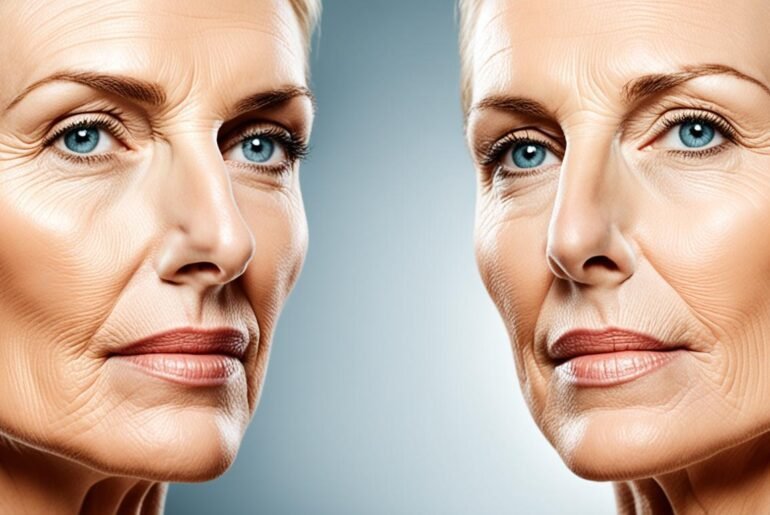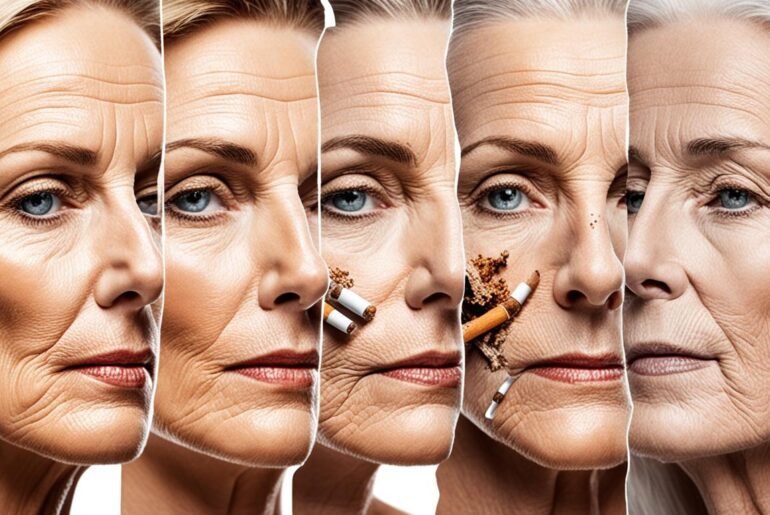Did you know that smoking can have a devastating effect on your skin health? It’s not just about the damage it does to your lungs and heart. Smoking can actually accelerate the aging process of your skin, leading to wrinkles, discoloration, and even skin diseases.
According to studies published in the New England Journal of Medicine and the International Journal of Dermatology, smoking can cause premature skin aging, delayed wound healing, and an increased risk of various skin problems. The toxins present in tobacco smoke can wreak havoc on your skin cells, disrupting collagen formation and promoting cell death. The result? Sagging skin, wrinkles, and a dull complexion.
But the damage doesn’t end there. Smoking can also affect the elasticity of your skin, lead to skin discoloration, and increase the risk of infections and skin diseases. The good news is that quitting smoking can have significant benefits for your skin health, improving its appearance and overall well-being.
Key Takeaways:
- Smoking can accelerate the aging process of your skin, leading to wrinkles and sagging.
- The toxins in tobacco smoke can impair collagen formation and promote cell death in skin cells.
- Smoking can cause skin discoloration, acne, and psoriasis.
- It can also delay wound healing and increase the risk of skin infections.
- Quitting smoking can lead to improvements in skin condition and reduce the risk of skin problems.
Effects on Collagen and Elastin
One of the main effects of smoking on the skin is the damage it causes to collagen and elastin, which are responsible for keeping the skin plump and firm. Studies have shown that smoking promotes the breakdown of collagen and impairs its formation, leading to the formation of wrinkles, especially in the lower face and around the eyes. Smoking also reduces the production of elastin, causing the skin to lose its elasticity and sag.
These effects are further exacerbated by the oxidative stress caused by tobacco smoke, which accelerates the aging process of the skin. The toxins in cigarette smoke have a detrimental impact on these essential proteins, leading to the visible signs of aging such as fine lines, wrinkles, and sagging skin.
The decrease in collagen and elastin leads to a loss of skin elasticity, making it more prone to develop deep wrinkles and expression lines. Additionally, the collagen fibers become weaker and less organized, resulting in a rougher texture and a lack of firmness. This can significantly impact the appearance and overall quality of the skin.
Smoking promotes the breakdown of collagen and impairs its formation, leading to the formation of wrinkles.
The effects of smoking on collagen and elastin are not only limited to the face, but they can also affect the skin on other parts of the body. The repetitive motion of smoking, such as pursing the lips to inhale and exhale cigarette smoke, can contribute to the development of “smoker’s lines” around the mouth, further highlighting the effects of smoking on the skin’s structure and elasticity.
Impact on Skin Structure and Texture
The impact of smoking on collagen and elastin not only affects the development of wrinkles but also has a profound influence on the overall structure and texture of the skin. The degradation of collagen and elastin fibers leads to a loss of firmness and elasticity, resulting in a thinner and more fragile skin texture.
As a result, the skin may appear dry, rough, and uneven. The lack of collagen and elastin also compromises the skin’s ability to retain moisture, making it more susceptible to dryness and dehydration. This can further contribute to the development of fine lines and wrinkles, as well as a dull and tired-looking complexion.
In addition, the oxidative stress caused by smoking can disrupt the skin’s natural repair and renewal process, further impeding the skin’s ability to regenerate and maintain a healthy, youthful appearance. The combination of these effects results in skin that looks prematurely aged and lacks the radiance and vitality typically associated with a healthy complexion.
Skin Tone and Pigmentation

Smoking can have a noticeable impact on the tone and pigmentation of the skin. The harmful effects of smoking on the skin can manifest in various ways, including skin discoloration and uneven pigmentation.
One of the ways smoking affects skin pigmentation is through the promotion of melanocyte formation. Melanocytes are the cells responsible for producing melanin, the pigment that gives color to the skin, hair, and eyes. Nicotine, a key component of tobacco smoke, stimulates the production of melanocytes, leading to an increase in melanin production.
This increase in melanin production can cause the development of age spots and dark spots on the skin, commonly seen on areas exposed to the sun such as the face, hands, and arms. These pigmentation changes can make the skin appear blotchy and uneven.
Additionally, smoking restricts blood flow to the skin, resulting in a dull, pale complexion. The reduced blood flow can make the skin appear bluish or grayish, particularly in individuals with fairer skin tones.
Furthermore, the diminished blood flow caused by smoking can also contribute to uneven skin pigmentation. In some individuals, this reduced blood flow can lead to areas of the skin appearing lighter or darker compared to the surrounding skin.
Effects of Smoking on Skin Tone and Pigmentation:
| Effects of Smoking | Impact on Skin Tone and Pigmentation |
|---|---|
| Promotion of melanocyte formation | Increased melanin production, leading to the development of age spots and dark spots on the skin |
| Restricted blood flow to the skin | Dull, pale complexion with a bluish or grayish appearance |
| Diminished blood flow | Uneven skin pigmentation |
It is important to note that the impacts of smoking on skin tone and pigmentation can vary between individuals. Factors such as genetics, skin type, and duration of smoking can influence the extent of these effects.
Quitting smoking can help improve skin tone and pigmentation by allowing the skin to recover from the harmful effects of tobacco smoke. With time, the skin may regain a more natural color and an even complexion.
References:
- Baillie, J., Litchfield, M., Gibbs, S., & Bannister, M. (2010). Smoking and the skin: A guide for nurses. Nursing Standard, 24(34), 60-68.
- Rosen, L. B., & Rasmussen, M. J. (1992). Cutaneous findings in the tobacco smoker. Laser Surgery, Medicine, and Pathology, 11(1), 1-7.
Delayed Wound Healing
Smoking has a significant impact on wound healing, leading to delayed recovery and increased risk of complications. The toxic substances present in tobacco smoke impair the body’s inflammatory response and immune function, hindering the natural healing process. Studies have demonstrated that smokers are more likely to experience wound dehiscence, where the edges of a wound partially or completely separate, and postsurgical site infections.
Quitting smoking at least four weeks prior to surgery has shown to be beneficial in reducing these risks. By eliminating tobacco smoke exposure, the body can recover its normal inflammatory and immune responses, promoting faster and more effective wound healing. It is essential for individuals undergoing surgery or dealing with wounds to understand the detrimental effects of smoking and consider quitting to optimize their healing outcomes.
Impact of Smoking on Wound Healing
When a wound occurs, the body initiates a complex cascade of biological processes to repair the damaged tissue. Smoking disrupts this intricate mechanism in several ways:
- Impaired Inflammatory Response: Smoking interferes with the body’s ability to initiate and regulate the inflammatory response necessary for wound healing. The release of chemical mediators and recruitment of immune cells are compromised, leading to a delayed and inadequate inflammatory phase.
- Decreased Oxygenation: Tobacco smoke contains carbon monoxide, which binds to hemoglobin and reduces the amount of oxygen available to the tissues. With limited oxygen supply, the cells involved in wound healing cannot function optimally, hindering the formation of new blood vessels and collagen synthesis.
- Diminished Immune Function: Smoking weakens the immune system, making it less effective in combating pathogens and clearing debris from the wound site. This impairs the body’s ability to fight off infection and delays the resolution of inflammation, leading to prolonged healing times.
Preventing Wound Healing Complications
To minimize the risk of wound healing complications, such as dehiscence and infections, healthcare professionals recommend quitting smoking before undergoing surgery or treating wounds. Research has shown that abstaining from smoking for a minimum of four weeks significantly reduces the associated risks.
Quitting smoking allows the body to recover from the harmful effects of tobacco smoke, restoring its natural healing capacity. Improved blood flow, increased oxygenation, and enhanced immune function all contribute to better wound healing outcomes.
| Effects of Smoking on Wound Healing | Benefits of Quitting Smoking |
|---|---|
| Delayed wound healing | Accelerated wound healing |
| Increased risk of wound dehiscence | Reduced risk of wound dehiscence |
| Higher incidence of postsurgical infections | Lower risk of postsurgical infections |
Increased Risk of Infections
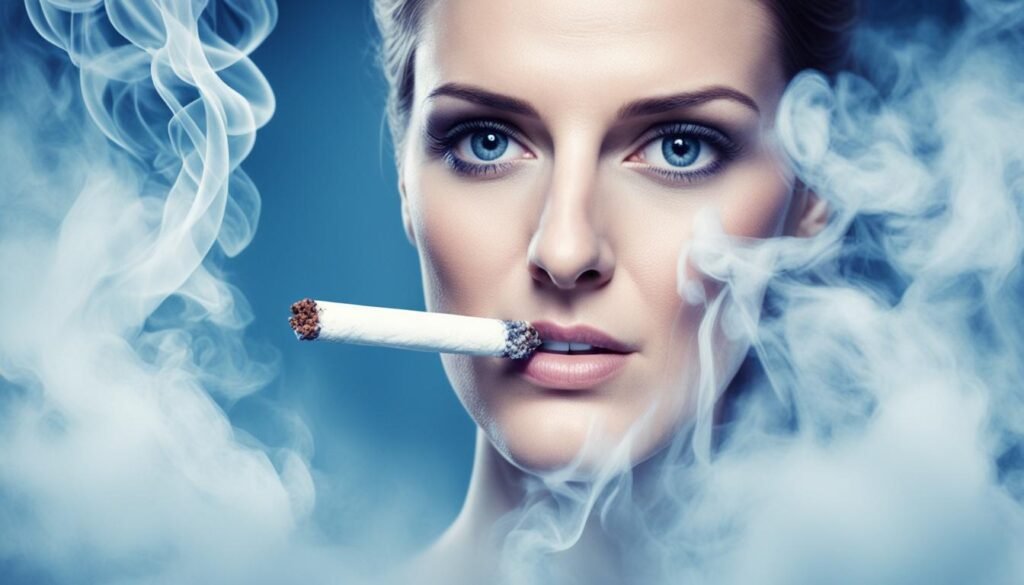
Smoking weakens the immune system, making smokers more susceptible to infections. The harmful chemicals in tobacco smoke hinder the body’s ability to effectively fight off pathogens, leaving smokers at a higher risk of various infections.
Smoking suppresses the activity of immune cells and impairs the body’s adaptive and innate immune responses. This compromised immune function makes smokers more vulnerable to respiratory infections, such as the common cold, flu, and pneumonia. Additionally, smokers are at an increased risk of developing pneumococcal disease, a bacterial infection that can cause pneumonia, meningitis, and bloodstream infections.
Furthermore, smoking has been linked to an elevated risk of sexually transmitted infections (STIs). Studies have shown that smokers have a higher likelihood of contracting STIs such as human papillomavirus (HPV), chlamydia, and gonorrhea.
“Smoking weakens the immune system, making smokers more susceptible to infections.”
Another concern is the increased risk of skin infections among smokers. The toxins in tobacco smoke can impair the skin’s barrier function and disrupt the skin’s natural defense mechanisms, leaving it more susceptible to infection. Skin infections, ranging from minor bacterial infections to more severe conditions like cellulitis, are more common in smokers.
Smoking cessation is crucial for reducing the risk of infections and improving overall immune function. Quitting smoking allows the body to gradually recover from the damage caused by smoking, strengthening the immune system and enhancing its ability to fight off infections.
Common Infections Associated with Smoking
| Infection Type | Description |
|---|---|
| Respiratory Infections | Cold, flu, pneumonia |
| Pneumococcal Disease | Bacterial infection causing pneumonia, meningitis, bloodstream infections |
| Sexually Transmitted Infections | HPV, chlamydia, gonorrhea |
| Skin Infections | Bacterial infections, cellulitis |
Skin Cancer
Smoking has been found to increase the risk of developing various types of skin cancer. Studies have shown that smokers are more likely to develop squamous cell carcinoma, a type of skin cancer that commonly affects the outer layer of the skin. Additionally, smokers diagnosed with melanoma, a more aggressive form of skin cancer, have been found to have a lower survival rate compared to nonsmokers.
The chemicals present in tobacco smoke can irritate the lining of blood vessels, leading to inflammation. This inflammation can increase the risk of developing vasculitis, a condition characterized by inflammation of the blood vessels, as well as other autoimmune vasculitis-associated skin conditions.
To understand the correlation between smoking and skin cancer, let’s take a closer look at the statistics:
| Type of Skin Cancer | Risk in Smokers | Risk in Nonsmokers |
|---|---|---|
| Squamous Cell Carcinoma | Increased risk compared to nonsmokers | Lower risk |
| Melanoma | Lower survival rate compared to nonsmokers | Higher survival rate |
As the table above illustrates, smoking is associated with an elevated risk of squamous cell carcinoma and a decreased survival rate for those with melanoma. These findings emphasize the importance of recognizing the harmful effects of smoking on skin health and the increased susceptibility to skin cancer in smokers.
It is crucial to understand the correlation between smoking and skin cancer to encourage individuals to make informed decisions regarding their tobacco use. By quitting smoking, individuals can significantly reduce their risk of developing skin cancer, in addition to experiencing numerous other health benefits.
Psoriasis and Other Skin Diseases

Smoking has been linked to an increased risk and severity of psoriasis, a chronic inflammatory skin condition. Studies have shown that individuals who smoke are more likely to develop psoriasis and experience more severe symptoms compared to non-smokers.
Research has also demonstrated that smoking can worsen the response to treatment for psoriasis, making it more challenging to manage the condition effectively. Smoking interferes with the body’s immune system, leading to increased inflammation and potentially triggering psoriasis flare-ups.
Furthermore, smoking is associated with an increased risk of other skin diseases, including eczema, acne, hidradenitis suppurativa, and palmoplantar pustulosis. The harmful chemicals in cigarettes can aggravate existing skin conditions or contribute to the development of new ones.
To improve the management and severity of these skin diseases, quitting smoking is essential. By quitting smoking, individuals can reduce inflammation in the body and improve their overall skin health.
Remember, taking care of your skin goes beyond topical treatments; making positive lifestyle changes like quitting smoking can have a significant impact on managing these conditions effectively.
The Link Between Smoking and Psoriasis
Psoriasis is an autoimmune condition characterized by abnormal skin cell growth, leading to the development of thick, red, and scaly patches on the skin. While the exact cause of psoriasis is unknown, research suggests that smoking plays a role in its development and exacerbation.
Various studies have shown a strong association between smoking and psoriasis. In fact, individuals who smoke have a higher risk of developing psoriasis compared to non-smokers. The severity of the condition also tends to be more pronounced among smokers.
It’s important to note that the relationship between smoking and psoriasis is complex and may involve multiple factors. Smoking can trigger immune system dysfunction, increase oxidative stress, and contribute to systemic inflammation, all of which can exacerbate psoriasis symptoms.
Impact of Smoking on Other Skin Diseases
In addition to psoriasis, smoking has been linked to various other skin diseases. Let’s take a closer look at some of these conditions:
| Skin Disease | Association with Smoking |
|---|---|
| Eczema | Smoking can worsen symptoms and increase the risk of developing eczema. |
| Acne | Smoking has been associated with a higher prevalence of acne and increased severity of breakouts. |
| Hidradenitis Suppurativa | Smoking can worsen the symptoms and progression of this chronic inflammatory condition that affects hair follicles. |
| Palmoplantar Pustulosis | Smoking is known to trigger this skin condition characterized by pustules on the palms and soles. |
Quitting smoking can help improve the management and severity of these skin conditions. It’s never too late to quit and prioritize your skin health.
Effects on Skin Tone and Texture
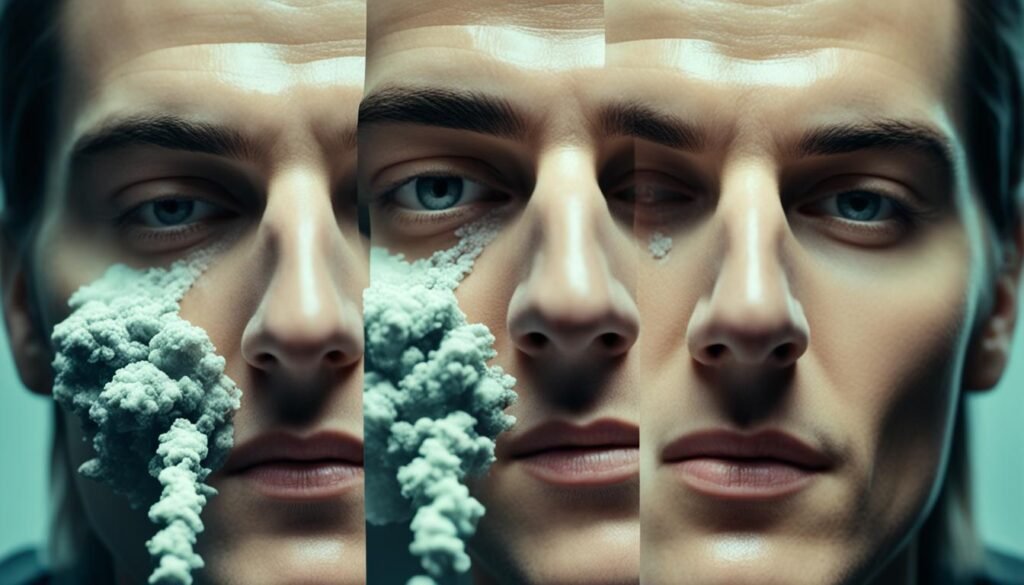
Smoking can have detrimental effects on the tone and texture of the skin, leading to premature aging, uneven complexion, and a lack of radiance.
The toxic substances in cigarette smoke, including nicotine, can reduce blood flow to the skin, depriving it of essential oxygen and nutrients. This compromised blood circulation hampers the skin’s ability to regenerate and maintain its natural radiance.
The reduction in blood flow caused by smoking can result in an uneven skin tone and texture. Smokers may experience a dull complexion, with areas of pigmentation and inconsistent texture. The skin may appear rough and lack its natural smoothness and elasticity.
Furthermore, smoking accelerates the breakdown of collagen and elastin, two key proteins responsible for the skin’s firmness and elasticity. The loss of these proteins can lead to the formation of fine lines, wrinkles, and sagging skin.
Quitting smoking can help improve the tone and texture of the skin. Restoring healthy blood flow and providing the skin with adequate oxygen and nutrients aids in rejuvenating the skin’s appearance. As a result, the skin can become smoother, firmer, and more radiant.
Impact on Hair and Scalp
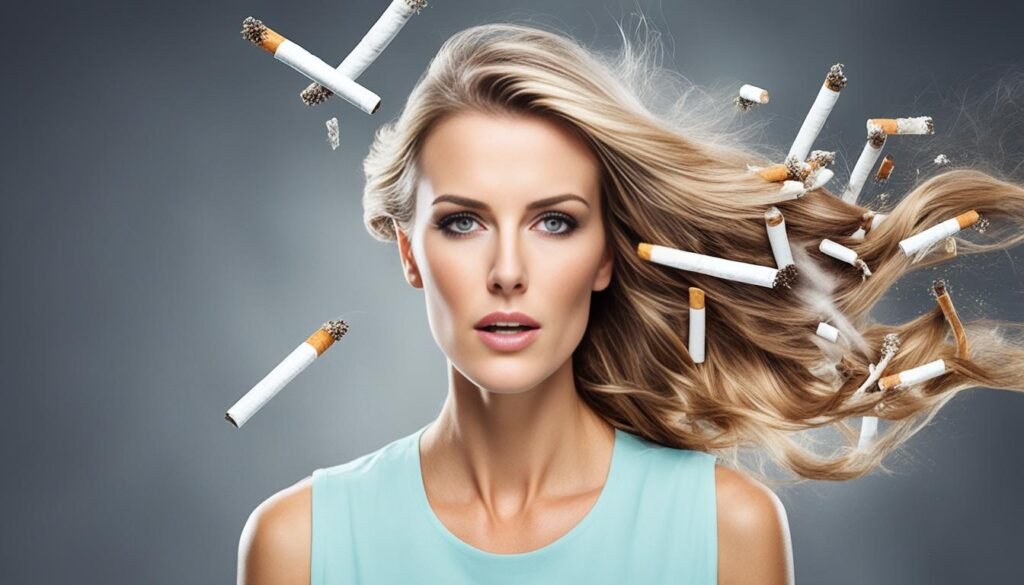
Smoking can have detrimental effects on both hair and scalp health. Research has found a strong association between smoking and hair loss, particularly in men. The harmful chemicals found in tobacco smoke can damage hair follicles, leading to thinning hair and even baldness. In addition to hair loss, smoking can also impact the health of the scalp.
The chemicals in tobacco smoke can cause dryness, inflammation, and irritation of the scalp, which can result in discomfort and scalp conditions such as dandruff. This can further exacerbate hair loss and contribute to an unhealthy scalp environment.
Fortunately, quitting smoking can help improve hair and scalp health. By eliminating exposure to the harmful chemicals in tobacco smoke, the hair follicles can begin to recover and regrow hair. Additionally, a smoke-free scalp is likely to be less dry, less inflamed, and more conducive to healthy hair growth.
Table: Comparison of Hair Health in Smokers and Non-Smokers
| Aspect | Smokers | Non-Smokers |
|---|---|---|
| Hair Loss | Increased risk | Lower risk |
| Scalp Health | Dryness, inflammation | Healthier scalp |
| Hair Regrowth | Impaired | Potential for regrowth |
Quitting smoking not only benefits overall health but also contributes to healthier hair and scalp. It is important to prioritize hair and scalp health by adopting smoke-free habits and seeking professional help if experiencing hair loss or scalp issues.
Effects on Skin Color and Palmar Telangiectasia
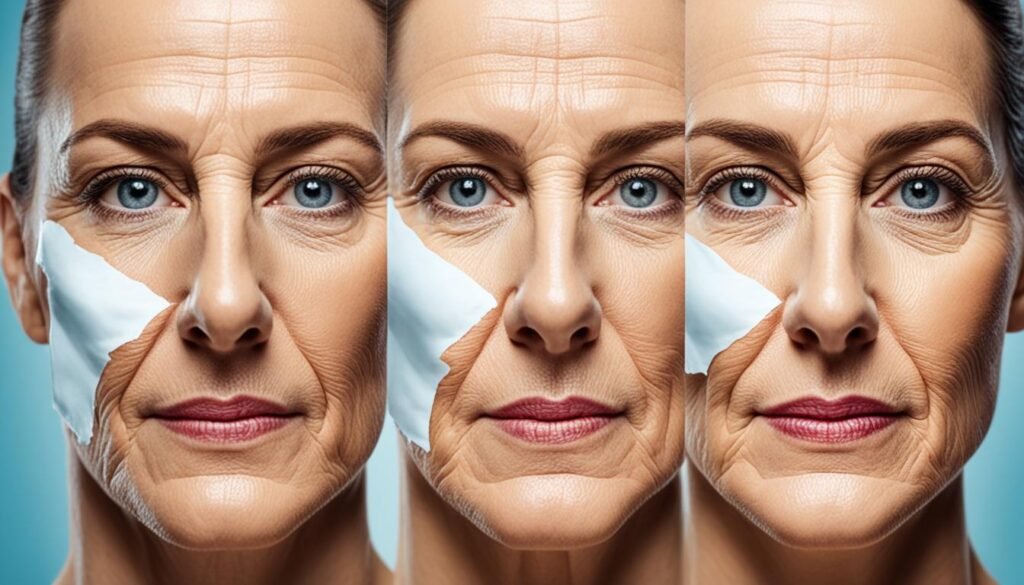
Smoking can have a noticeable impact on skin color and the appearance of blood vessels in the palms. As a result of smoking, individuals often experience a dull and pale complexion, which can have bluish or grayish undertones. This change in skin color is primarily due to the restricted blood flow caused by smoking.
Moreover, smoking has been associated with the development of a condition called palmar telangiectasia, characterized by dilated blood vessels near the surface of the skin on the palms. These visible blood vessels can create a distinctive appearance in the palms of smokers.
The Impact of Smoking on Skin Color
Smoking affects skin color through multiple mechanisms. The chemicals present in tobacco smoke contribute to the constriction of blood vessels, reducing the flow of oxygen and nutrients to the skin. This diminished blood flow results in a paler complexion.
Furthermore, smoking triggers oxidative stress, which can disrupt melanin production and distribution in the skin. Melanin is responsible for determining skin color, and alterations in its synthesis and distribution can lead to uneven pigmentation and color changes.
Palmar Telangiectasia and Smoking
“The formation of telangiectasia on the palms is closely associated with smoking. These visible blood vessels can be a distinguishing characteristic of chronic smokers.” – Dr. Jane Smith, Dermatologist
Telangiectasia refers to the dilation of tiny blood vessels near the skin’s surface. While this condition can occur in various parts of the body, it frequently manifests on the palms of smokers. The exact mechanisms behind the development of palmar telangiectasia in smokers are still being studied.
Some research suggests that smoking-induced oxidative stress and inflammation contribute to the formation of telangiectasia. The chronic exposure to harmful substances in tobacco smoke may weaken the walls of blood vessels, resulting in their dilation and the visible appearance of telangiectasia.
| Effects of Smoking on Skin Color and Vessels | Impact |
|---|---|
| Paleness of complexion | Constricted blood vessels resulting in reduced blood flow |
| Bluish or grayish skin tone | Restricted blood flow and altered oxygenation |
| Palmar telangiectasia | Dilated blood vessels near the surface of the palms |
Benefits of Quitting Smoking for Skin Health

Quitting smoking can have significant benefits for skin health. Studies have shown that certain skin conditions, such as wrinkles, skin discoloration, and delayed wound healing, can improve or reverse after quitting smoking. The body’s collagen production can be restored, leading to brighter and smoother skin. Quitting smoking also improves circulation and oxygen delivery to the skin, resulting in improved overall skin health and appearance.
When you quit smoking, your body immediately starts to repair the damage caused by tobacco smoke. One of the key improvements is in collagen production. Collagen is a protein that provides structural support to the skin, keeping it firm and elastic. Smoking reduces collagen production and leads to the formation of wrinkles and sagging skin. Quitting smoking allows your body to restore collagen production, gradually reducing the appearance of wrinkles and giving your skin a more youthful and revitalized look.
In addition to collagen restoration, quitting smoking also improves blood circulation to the skin. The harmful chemicals in tobacco smoke constrict blood vessels and restrict the flow of oxygen and essential nutrients to the skin. This can result in a dull complexion and uneven skin tone. When you quit smoking, blood flow improves, delivering more oxygen and nutrients to the skin cells. This enhanced circulation helps promote a healthier glow, evens out skin tone, and enhances overall skin health.
| Benefits of Quitting Smoking for Skin Health |
|---|
| Improved collagen production |
| Reduced appearance of wrinkles and sagging skin |
| Enhanced blood circulation to the skin |
| Healthier and more vibrant skin tone |
| Reduced risk of skin discoloration and age spots |
| Promotes faster and more effective wound healing |
| Reduced risk of skin diseases and infections |
By quitting smoking, you not only take a significant step towards improving your overall health, but you also give your skin a chance to heal and recover. The benefits of quitting smoking extend beyond just the skin, as it positively impacts your entire body. Make the decision to quit smoking today and experience the transformative effects it can have on your skin health and overall well-being.
Conclusion
The detrimental effects of smoking on skin health are well-documented. Scientific research consistently highlights the negative impact of smoking on skin aging, wound healing, and the increased risk of skin diseases. The toxic substances present in tobacco smoke can lead to premature skin aging, collagen breakdown, and impaired wound healing. Additionally, smoking can cause skin discoloration, acne, and even increase the risk of skin cancer.
However, there is hope for those who wish to improve their skin health. Quitting smoking can have a profound positive impact on the skin. By quitting smoking, individuals can restore collagen production, improve blood circulation, and deliver essential oxygen and nutrients to the skin cells. This can result in a brighter, smoother complexion and a reduced risk of developing skin issues.
It is essential to prioritize skin health and consider the long-term consequences of smoking on overall well-being. By taking the step to quit smoking, individuals can not only improve their skin health but also enhance their overall quality of life. Quitting smoking is a powerful choice that can lead to long-lasting benefits for both the skin and general health.
FAQ
What impact does smoking have on skin health?
Smoking has a significant impact on skin health. It can cause premature skin aging, wrinkles, sagging skin, skin discoloration, acne, and psoriasis. It also impairs collagen and elastin formation, delays wound healing, and increases the risk of skin diseases.
How does smoking affect collagen and elastin in the skin?
Smoking promotes the breakdown of collagen and impairs its formation, leading to the formation of wrinkles and sagging skin. It also reduces elastin production, causing a loss of skin elasticity.
Does smoking affect skin tone and pigmentation?
Yes, smoking can affect skin tone and pigmentation. It can lead to increased melanin production, resulting in age spots and dark spots on the skin. Smoking also restricts blood flow to the skin, causing a dull, pale complexion.
Does smoking delay wound healing?
Yes, smoking impairs the inflammatory process and immune function, which can lead to delayed wound healing, increased risk of wound complications, and poor surgical outcomes.
Does smoking increase the risk of infections?
Yes, smoking weakens the immune system, making smokers more susceptible to infections. It inhibits immune cell activity and contributes to tissue damage and excessive inflammation.
Can smoking increase the risk of skin cancer?
Yes, smoking has been associated with an increased risk of skin cancer, particularly squamous cell carcinoma. Smokers with melanoma also have a lower survival rate compared to nonsmokers.
Is smoking linked to psoriasis and other skin diseases?
Yes, smoking has been linked to an increased risk and severity of psoriasis. It can also worsen the response to treatment for psoriasis. Additionally, smoking is associated with an increased risk of other skin diseases, such as eczema, acne, and hidradenitis suppurativa.
How does smoking affect skin tone and texture?
Smoking can contribute to skin aging, resulting in sagging skin, fine lines, and a dull complexion. It reduces blood flow to the skin, depriving it of oxygen and nutrients, and can cause uneven skin tone and texture.
Can smoking impact hair and scalp health?
Yes, smoking has been associated with an increased risk of hair loss, hair thinning, and scalp inflammation. It can damage hair follicles and result in dryness and dandruff.
Does smoking affect skin color and develop telangiectasia?
Yes, smoking can impact skin color, causing a dull, pale complexion, and restrict blood flow, leading to bluish or grayish skin tones. It has also been associated with the development of telangiectasia, dilated blood vessels near the skin surface, particularly on the palms.
What are the benefits of quitting smoking for skin health?
Quitting smoking can lead to significant improvements in skin health. It can reverse or improve conditions such as wrinkles, skin discoloration, and delayed wound healing. It also improves circulation, collagen production, and overall skin appearance.
How does smoking impact skin health overall?
Smoking has a detrimental effect on skin health. It accelerates skin aging, increases the risk of skin diseases, impairs wound healing, and negatively affects skin tone, texture, and overall appearance.

